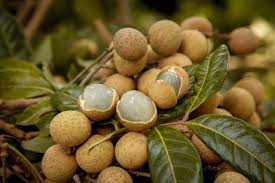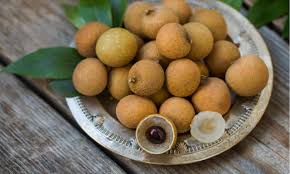Longans, scientifically known as Dimocarpus longan, are delightful tropical fruits cherished for their sweet and succulent flavor. These small, round fruits belong to the soapberry family and are native to Southeast Asia. With a thin, brownish skin and translucent flesh, longans are often referred to as “dragon eyes” due to the fruit’s translucent appearance resembling an eyeball when peeled.
The longan tree, a member of the Sapindaceae family, produces clusters of these delectable fruits. The fruit’s flesh is juicy and subtly sweet, making it a popular choice for fresh consumption or as an ingredient in various culinary delights. Longans are commonly enjoyed on their own, added to fruit salads, or used in desserts and beverages.
Harvested during the late summer and early fall, longans have become a staple in many tropical regions. The cultivation of longan trees requires a warm and humid climate, and they thrive in well-drained, sandy loam soil. These hardy trees can reach heights of up to 20 meters and are known for their dense foliage, providing ample shade for the delicate longan fruit to develop.
One of the distinct features of longans is their nutritional profile. They are a good source of vitamin C, which contributes to overall immune health, and contain essential minerals such as potassium and magnesium. Additionally, longans offer a modest amount of dietary fiber, aiding in digestion.
Longans have not only found their place in culinary traditions but also in traditional medicine. In some cultures, longans are believed to have cooling properties and are used to alleviate conditions related to heat, such as fever. The fruit’s seeds are also sometimes used in traditional herbal remedies.
As global interest in diverse and exotic fruits grows, longans have gained popularity beyond their native regions. Efforts in cultivation and export have allowed people around the world to experience the unique and delightful taste of longans. Whether enjoyed fresh, dried, or incorporated into various dishes, longans continue to capture the palates of those seeking a tropical and refreshing culinary experience.
Read Also: Jersey Cow: Grooming and Care Guide
The History of Longans

Longans have a rich history rooted in Southeast Asia, where they have been cultivated for centuries. The scientific name, Dimocarpus longan, reflects their botanical classification. These small, round fruits have been a culinary and cultural staple in countries like China, Thailand, Vietnam, and Malaysia.
Longans were first documented in ancient Chinese texts, dating back over 2000 years. They were highly valued in Chinese culture not only for their sweet taste but also for their perceived medicinal properties. Longans were often used to promote relaxation, relieve stress, and alleviate ailments associated with heat.
Over time, the cultivation of longan trees spread to other parts of Southeast Asia, where the tropical climate provided an ideal environment for their growth. The fruit became an integral part of local cuisines, featuring in various desserts, beverages, and as a refreshing snack.
As trade routes expanded, longans found their way to different parts of the world. The Portuguese are credited with introducing longans to Europe during their explorations in the 16th century. However, it was in the 19th century that longan cultivation began in earnest in places like the United States, particularly in Florida and California.
Today, longans have become a global phenomenon, with increased cultivation in various tropical and subtropical regions. The fruit’s popularity has transcended cultural boundaries, and it is now enjoyed by people worldwide. The history of longans reflects not only their journey from ancient Chinese texts to modern international markets but also the cultural significance they hold in the regions where they have been cultivated for centuries.
The Nutritional Values of Longans
Longans boast a nutritional profile that contributes to their appeal as a healthy and delicious fruit. These tropical delights are a good source of vitamin C, an essential antioxidant that supports the immune system and promotes skin health. A single serving of longans can provide a notable portion of the daily recommended intake of vitamin C.
Additionally, longans contain essential minerals, with potassium being a prominent component. Potassium plays a crucial role in maintaining proper heart and muscle function, as well as helping to regulate blood pressure. Incorporating longans into your diet can contribute to your overall potassium intake.
Furthermore, longans offer a modest amount of dietary fiber. Fiber is essential for digestive health, promoting regular bowel movements and helping to prevent constipation. Including fiber-rich fruits like longans in your diet supports a healthy digestive system.
The fruit also contains natural sugars, mainly fructose and glucose, providing a quick and natural energy boost. While longans are a sweet treat, they have a relatively low calorie content, making them a suitable choice for those seeking a flavorful snack without excessive calories.
It’s worth noting that longans are a hydrating fruit, with a high water content that contributes to overall hydration. Staying well-hydrated is vital for various bodily functions, including temperature regulation, joint lubrication, and nutrient transportation.
Longans offer a combination of vitamins, minerals, and dietary fiber, making them not only a tasty addition to your diet but also a nutritious one. As with any food, moderation is key, and incorporating a variety of fruits and vegetables ensures a well-rounded and balanced nutritional intake.
Read Also: The Appearance and Features of Goats
Health Benefits of Longans

Longans come with several health benefits, making them a nutritious addition to your diet. Here are some of the advantages associated with the consumption of longans:
1. Rich in Antioxidants: Longans are a good source of antioxidants, including vitamin C. Antioxidants help combat oxidative stress in the body, reducing the risk of chronic diseases and supporting overall well-being.
2. Immune System Support: The vitamin C content in longans plays a vital role in supporting the immune system. Regular consumption can contribute to the body’s defense against infections and illnesses.
3. Heart Health: Longans contain potassium, a mineral that plays a key role in maintaining heart health. Adequate potassium intake is associated with lower blood pressure, reducing the risk of cardiovascular issues.
4. Digestive Health: The dietary fiber in longans promotes healthy digestion. Fiber aids in regular bowel movements, preventing constipation, and supporting a well-functioning digestive system.
5. Natural Energy Boost: Longans contain natural sugars like fructose and glucose, providing a quick and natural energy boost. This makes them a healthy alternative to processed snacks for those needing a pick-me-up during the day.
6. Hydration: With a high water content, longans contribute to overall hydration. Staying well-hydrated is essential for various bodily functions, including maintaining skin health and supporting joint function.
7. Stress Relief: In traditional medicine, longans are believed to have calming properties, helping to alleviate stress and promote relaxation. While more research is needed in this area, some people find the fruit beneficial for its soothing effects.
While longans offer health benefits, they should be consumed as part of a balanced diet. Including a variety of fruits and vegetables ensures a diverse range of nutrients essential for overall health. As with any dietary changes, it’s advisable to consult with a healthcare professional for personalized advice.
How to Grow Longans (Growing Guide)
Growing longans can be a rewarding experience, provided you give them the right conditions to thrive. Here’s a basic guide on how to grow longans:
1. Climate: Longans thrive in tropical and subtropical climates. They prefer a warm, humid environment and are sensitive to cold temperatures. In colder regions, consider growing them in containers that can be moved indoors during winter.
2. Soil: Plant longans in well-draining soil with a slightly acidic to neutral pH. Sandy loam soil is ideal. Ensure good drainage to prevent waterlogging, as longans are susceptible to root rot.
3. Planting: Choose a sunny location for planting, as longans require full sun to produce fruit. Select a site with at least 6-8 hours of direct sunlight daily. Dig a hole twice the size of the root ball of the longan sapling.
Place the sapling in the hole, ensuring it’s at the same depth as it was in the nursery container. Backfill the hole with soil and water thoroughly.
4. Watering: Longans need regular watering, especially during dry periods. However, they are sensitive to overwatering, so maintain a consistent watering schedule. Deep, infrequent watering is generally preferable to frequent shallow watering.
5. Fertilization: Fertilize young longan trees with a balanced fertilizer during the growing season. Once the tree is established, reduce the frequency but increase the amount of fertilizer. Organic compost can also be beneficial.
6. Pruning: Prune longan trees to maintain shape, remove dead or diseased branches, and improve air circulation. This helps prevent pests and diseases.
7. Mulching: Apply a layer of organic mulch around the base of the tree to conserve moisture, suppress weeds, and regulate soil temperature. Keep the mulch a few inches away from the trunk to prevent rot.
8. Pests and Diseases: Keep an eye out for pests such as aphids, scale insects, and mites. Treat infestations promptly. Longans can be susceptible to fungal diseases; ensure good air circulation and avoid overwatering to prevent these issues.
9. Harvesting: Longans typically bear fruit within 3-5 years. Harvest when the fruit skin turns brown, and the flesh is translucent. The fruit is usually ready for harvest in late summer to early fall.
Read Also: 5 things you must do if you want to be healthy
